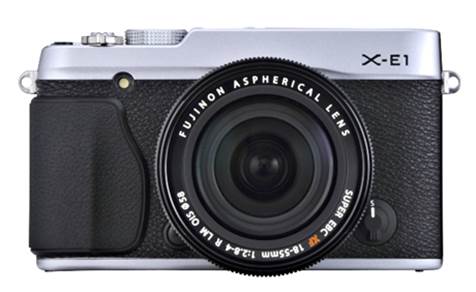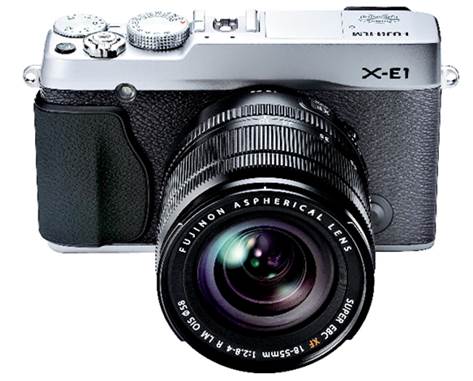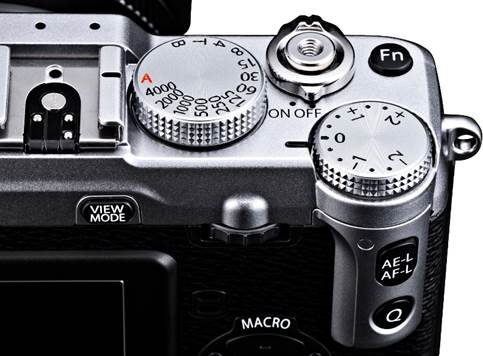With many of the same features as the
X-Prol, but more affordable, is this the perfect enthusiast CSC?
The past couple of years has seen a bit of
a renaissance for the Fujifilm brand in the eyes of the photographer, starting
with the lovely X100 premium compact camera that was then followed by the X10
and the company’s first Compact System Camera, the X-Pro1.
With rangefinder-inspired looks and a brand
new sensor technology that’s impressed, the X-Prol has found its way into the
camera bags of both professionals and keen enthusiasts. While it looks a
bargain compared to a certain German brand of rangefinder camera that it has
taken its inspiration from, the X-Prol is a premium camera in its own right.
But with the arrival of the X-E1, Fujifilm hopes to broaden the appeal of its
X-series CSC range further still.
Features
One of the jewels in the crown of the
X-Pro1 is the 16MP APS-C sized sensor, and the good news is that the X-E1 uses
the very same chip.
It’s a little bit special because of the
unique and clever way the sensor’s color filter array is arranged. Most digital
cameras feature a traditional Bayer filter array to decipher color information,
but this results in aliasing effects such as moire patterning. An anti-aliasing
filter in front of the sensor is then required to eliminate such artefacts, but
works by ever so slightly blurring the image and results in a very minor loss
in critical sharpness. The X-Trans CMOS sensor inside the X-E1 however uses an
array of red, green and blue pixels that aren’t arranged in a repetitive order.
With a structure more akin to film, the sensor can effectively minimize moire
and false color, eliminating the need for an anti-alialsing filter, which
should in turn deliver far sharper results than more conventional sensors. On
top of this, there’s Fujifilm’s EXR Pro image processor on board, and while the
native ISO range of 200-6400 is fairly moderate, it can be expanded to an ISO
equivalent of 100-25,600.

Thanks
to the clever X-Trans design of the CMOS sensor, the level of detail on offer
is impressive, delivering some of the best results we’ve seen from a CSC.
As you’d expect, the X-E1 uses the same X
mount as the X-Prol, with the range of XF lenses available growing from the
initial three to now include a Fujinon XF 14mm f/2.8 that delivers a 35mm focal
length equivalent of 21mm, while the first zoom lens of the range is the
18-55mm f/2.8-4 that’ll be bundled with the X-E1 from X-series stockists. With
a 35mm focal length equivalent of 27-84mm, it’s far removed from what you
usually associate with this “kit lens’’ focal length. The finish not only
matches other XF lenses (i.e. very good), but the fast if variable maximum
aperture off/2.8-4 means it’s a highly versatile proposition. Especially when
you factor in the built in OIS image stabilization system equivalent to four
stops and a responsive linear motor.
As it features a variable aperture, there’s
no longer a marked aperture ring. Instead, it rotates continuously, with each
click round representing a third-stop change. To set the camera to a set
aperture (for instance, when you want to shoot in shutter priority), there’s a
separate switch on the side to select this. Since the launch of the X-Prol
we’ve also seen the arrival of an M Mount adapter, allowing you to use some
lovely Leica glass as well.

The
Motion Panorama mode captures multiple images as you pan, then stitches the
shots together.
Probably the most notable difference
between the X-Pro1 and the X-E1 is the viewfinder. Rather than using the clever
hybrid viewfinder that provides both optical and electronic options, the
viewfinder in the X-El is solely electronic, saving both on weight and the cost
implications incurred. But Fujifilm hasn’t just done away with the optical
viewfinder, leaving you with the same EVF as the X-Prol. Instead, they’ve
improved on the X-Pro1’s 1.44m-dot LCD EVF, fitting the X-E1 with a 2.36m-dot
OLED unit in the X-E1.
At the rear of the X-E1 is a 2.8in screen
with a 460k-dot resolution that’s the same as that found on the X100, but a
touch smaller than the 3in display on the X-Prol that sports a huge 1,230k-dot
resolution. Unlike the X-Prol, the X-E1 sports a pop-up built-in TTL flash,
while there’s also a hotshoe to attach one of Fujifilm’s dedicated flashguns.
Just like the X100 and X-Pro1 models, the
X-E1 uses a 49-point contrast-detect AF system, fine-tuning the algorithms from
the system found in the X-Prol to provide what promises to be much faster
focusing speeds and low-light performance,
Design
With the absence of an optical viewfinder,
the X-E1, from the front at least, looks a little less rangefinder-like than
either the X100 or X-Pro1. That’s not to say that the X-E1 is any less
successful in the design department. It’s a nice-looking piece of kit, with the
sculptured lip running along most of the front top panel that helps to produce
a sleek, premium-looking camera that’s a mix of contemporary and nostalgia.
While it’s available in black or silver, we think the silver model definitely
has the edge, and one that’s bound to be the subject of the odd admiring glance
or two.
The X-E1 has also been on a bit of a
weight-loss program, and is noticeably less bulky than the X-Pro1, with not
only a much smaller footprint but also height as well, making it pretty similar
in size to the X100. The build quality hasn’t been compromised though, with top
and front covers made from die-cast magnesium, along with a decent rubber grip.
Like the X100 and X-Prol, you won’t find a plethora of automated controls and
shooting modes on the X-E1.
Virtually mirroring the control layout of
the X-Prol, there’s a shutter speed dial on the top plate with an "A”
setting for auto control, while the aperture is set via the lens’s aperture
ring - again with each lens sporting an “A” setting to let the camera take
over. So while the X-El can be used in Program mode by having both aperture and
shutter speed settings set to A, the X-E1 encourages you to be more involved
and take control.

The
X-EVs Raw files have plenty of latitude, allowing you to really push them in
post-processing, as we’ve done here.
The shutter speed dial itself is made from
machined metal, with a beautifully fine-grooved edge, though unlike the X-Pro1,
it doesn’t feature a central lock to stop it inadvertently getting knocked out
of position. Next to that is the exposure compensation dial with -/+2
compensation in third stop increments and sunken into the body just like the
one on the X-Pro1 to avoid inadvertent knocks.
Also on the top plate is the on/off switch
that wraps itself round the shutter button that features a traditional screw
cable release, though the X-E1 can also be triggered with RR-80 remote release.
You’ll also find a small Fn function button which is set by default to control
ISO, though this can be customized in the camera’s menu should you prefer.
Moving to the rear of the X-E1, and X-Prol
users will feel right at home, with an almost identical button layout. The only
notable change is the Playback button moving from the right of the screen to
fall in-line with the drive, metering mode and AF access points that also
double up as zoom in, zoom out and delete controls when reviewing images.
There’s also a view mode selector, allowing you to toggle between the
viewfinder and rear screen, though there is an eye-sensor next to the
viewfinder to automatically swap to the EVF when you raise the X-El to your
eye.